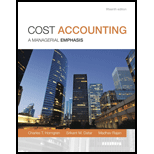
(1)(a)
To compute: The direct and indirect cost rate per professional labor hour under actual costing.
Given information:
2014,
Actual indirect cost is $744,000.
Actual labor hour is 15,500.
(b)
To compute: The direct and indirect cost rate per professional labor hour under normal costing.
Given information:
2014,
Budgeted direct cost is $960,000.
Budgeted indirect cost is $720,000.
Budgeted labor hour is 16,000.
(c)
To compute: The direct and indirect cost rate per professional labor hour under variation from normal costing.
2.
To explain: The job costing system for C from part a, b and c above.
3.
(a)
To compute: The cost of audit using actual costing.
(b)
To compute: The cost of audit using normal costing.
(c)
To compute: The cost of audit using variation from normal costing that uses budgeted rates.
Want to see the full answer?
Check out a sample textbook solution
Chapter 4 Solutions
Cost Accounting (15th Edition)
- Please provide the answer to this general accounting question using the right approach.arrow_forwardPlease provide the correct answer to this general accounting problem using valid calculations.arrow_forwardCan you explain the correct methodology to solve this general accounting problem?arrow_forward
- Please provide the solution to this general accounting question with accurate financial calculations.arrow_forwardI need help with this general accounting question using standard accounting techniques.arrow_forwardThe Great Eastern TableGreat Eastern Table Company produces dining tables in a three-stage process: Sawing, Assembly, and Staining. Costs incurred in the Sawing Department during September are summarized as follows: Working in process inventory sawing. September 1 balance = 0Direct materials = 1,860,000Direct labor = 143,000Manufacturing overhead = 161,500Direct materials (lumber) are added at the beginning of the sawing process, while conversion costs are incurred evenly throughout the process. September activity in the Sawing Department included sawing of 13,000 meters of lumber, which were transferred to the Assembly Department. Also, work began on 2,000 meters of lumber, which on September 30 were 75% of the way through the sawing process.arrow_forward
- Black Oil Company is trying to decide whether to lease or buy a new computer-assisted drilling system for its extraction business. Management has already determined that acquisition of the system has a positive NPV. The system costs $9.4 million and qualifies for a 25% CCA rate. The equipment will have a $975,000 salvage value in five years. Black Oil’s tax rate is 36%, and the firm can borrow at 9%. Cape Town Company has offered to lease the drilling equipment to Black Oil for payments of $2.15 million per year. Cape Town’s policy is to require its lessees to make payments at the start of the year. Suppose it is estimated that the equipment will have no savage value at the end of the lease. What is the maximum lease payment acceptable to Black Oil now?arrow_forwardI need help with this general accounting question using the proper accounting approach.arrow_forwardSpace Exploration Technology Corporation (Space X), is an aerospace manufacturer that sells stock engine components and tests equipment for commercial space transportation. A new customer has placed an order for eight high-bypass turbine engines, which increase fuel economy. The variable cost is $1.6 million per unit, and the credit price is $1.725 million each. Credit is extended for one period, and based on historical experience, payment for about one out of every 200 such orders is never collected. The required return is 1.8% per period. Required Assuming that this is a one-time order, should it be filled? The customer will not buy if credit is not extended. What is the break-even probability of default in part 1? Suppose that customers who don’t default become repeat customers and place the same order every period forever. Further assume that repeat customers never default. Should the order be filled? What is the break-even probability of default?arrow_forward
- Can you explain the correct methodology to solve this general accounting problem?arrow_forwardPlease help me solve this general accounting question using the right accounting principles.arrow_forwardSuppose during 2025 that Federal Express reported the following information (in millions): net sales of $82,500 and net income of $185. Its balance sheet also showed total assets at the beginning of the year of $27,000 and total assets at the end of the year of $23,000. Calculate the asset turnover and return on assets. (Round answers to 2 decimal places, e.g. 6.25 or 6.25%.) Asset turnover Return on assets times %arrow_forward

 AccountingAccountingISBN:9781337272094Author:WARREN, Carl S., Reeve, James M., Duchac, Jonathan E.Publisher:Cengage Learning,
AccountingAccountingISBN:9781337272094Author:WARREN, Carl S., Reeve, James M., Duchac, Jonathan E.Publisher:Cengage Learning, Accounting Information SystemsAccountingISBN:9781337619202Author:Hall, James A.Publisher:Cengage Learning,
Accounting Information SystemsAccountingISBN:9781337619202Author:Hall, James A.Publisher:Cengage Learning, Horngren's Cost Accounting: A Managerial Emphasis...AccountingISBN:9780134475585Author:Srikant M. Datar, Madhav V. RajanPublisher:PEARSON
Horngren's Cost Accounting: A Managerial Emphasis...AccountingISBN:9780134475585Author:Srikant M. Datar, Madhav V. RajanPublisher:PEARSON Intermediate AccountingAccountingISBN:9781259722660Author:J. David Spiceland, Mark W. Nelson, Wayne M ThomasPublisher:McGraw-Hill Education
Intermediate AccountingAccountingISBN:9781259722660Author:J. David Spiceland, Mark W. Nelson, Wayne M ThomasPublisher:McGraw-Hill Education Financial and Managerial AccountingAccountingISBN:9781259726705Author:John J Wild, Ken W. Shaw, Barbara Chiappetta Fundamental Accounting PrinciplesPublisher:McGraw-Hill Education
Financial and Managerial AccountingAccountingISBN:9781259726705Author:John J Wild, Ken W. Shaw, Barbara Chiappetta Fundamental Accounting PrinciplesPublisher:McGraw-Hill Education





